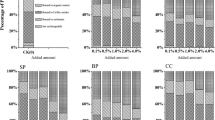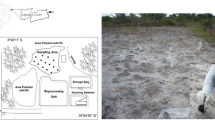Abstract
Purpose
The combined contamination of Pb, Zn, Cu, Cd, and As in the soils near lead/zinc mine waste posed a potential threat to the surrounding environment. Mitigation methods are needed to reduce the environmental risk. The aims of this paper were to evaluate the feasibility and efficiency of different forms of phosphates in remediating combined contamination caused by multi-metals and arsenic near the lead/zinc mining tailings.
Materials and methods
The tested soil was taken from a clayey illitic thermic typic epiaquepts soil (depth of 0–20 cm) near a lead and zinc mine tailing, located in Shaoxing, Zhejiang Province, China. Four pure chemical reagents, K2HPO4, Ca(H2PO4)2.2H2O, Ca3(PO4)2, and Ca5(PO4)3OH, were added to the soil in solution form as the trace metal stabilizing additives at a P application rate equivalent to 2,283 mg P/kg-soil and P/Pb molar ratio of 1. Shifts in trace metal speciation were determined using sequential extraction procedures and relative toxicities were evaluated using the standard EPA toxicity characteristic leaching procedure (TCLP).
Results and discussion
The addition of K2HPO4, Ca3(PO4)2, Ca5(PO4)3OH, and Ca(H2PO4)2.2H2O in the contaminated soil at the phosphorus application rate 2,283 mg P/kg-soil reduced Pb concentrations in TCLP extraction solution from 90.47 to 56.05, 83.80, 67.78, and 86.32 mg/kg (38.0, 7.36, 25.1, and 4.59% reduction), respectively. Sequential extraction analysis showed that phosphate treatments caused the transformation of easily available trace metal species to more stable forms. However, TCLP As in the soil increased from its initial value of 0.23 to 2.1, 0.70, 0.67, and 0.77 mg/kg, respectively, for the four treatments. The TCLP leachable As concentration of the K2HPO4-treated soil was about nine times of that from the untreated soil.
Conclusions
The addition of K2HPO4, Ca3(PO4)2, Ca5(PO4)3OH, and Ca(H2PO4)2.2H2O were effective in reducing water soluble and exchangeable Pb, Zn, Cu, and Cd, and minimizing TCLP-extractable Pb, Zn, and Cu. The sequential extraction test and the TCLP indicate that Ca5(PO4)3OH treatment has a higher potential in immobilizing Pb, Zn, Cu, and Cd, though a slight enhancement of As mobility, comparing with other phosphate treatments.




Similar content being viewed by others
References
Adamo P, Arienzo M, Bianco MR, Terribile F, Violante P (2002) Heavy metal contamination of the soils used for stocking raw materials in the former ILVA iron–steel industrial plant of Bagnoli (southern Italy). Sci Total Environ 295:17–34
Adriano DC (2001) Trace elements in terrestrial environments: biogeochemistry, bioavailability and risks of metals. Springer, New York
Anju M, Banerjee DK (2010) Comparison of two sequential extraction procedures for heavy metal partitioning. Chemosphere 78:1393–1402
Basta NT, Gradwohl R, Snethen KL, Schroder JL (2001) Chemical immobilization of lead, zinc, and cadmium in smelter-contaminated soils using biosolids and rock phosphate. J Environ Qual 30:1222–1230
Boisson J, Ruttens A, Menh M, Vangronsveld J (1999) Evaluation of hydroxyapatite as a metal immobilizing soil additive for the remediation of polluted soils. Part1. Influence of hydroxyapatite on metal exchangeability in soil, plant growth and plant metal accumulation. Environ Pollut 104:225–233
Bolan NS, Adriano DC, Naidu R (2003) Role of phosphorus in immobilization and bioavailability of heavy metals in the soil-plant system. Rev Environ Contam Toxicol 177:1–44
Brümmer G, Tiller KG, Herms U, Clayton PM (1983) Adsorption—desorption and/or precipitation—dissolution processes of zinc in soils. Geoderma 31(4):337–354
Caille N, Swanwick S, Zhao FJ, McGrath SP (2004) Arsenic hyperaccumulation by Pteris vittata from arsenic contaminated soils and the effect of liming and phosphate fertilization. Environ Pollut 132(1):113–120
Cao XR, Ma LQ, Singh SP, Harris WG (2003) Phosphate-induced metal immobilization in a contaminate site. Environ Pollut 122:19–28
Chlopecka A, Adriano DC (1996) Mimicked in-situ stabilization of metals in a cropped soil: bioavailability and chemical form of zinc. Environ Sci Technol 30:3294–3303
Christensen TH, Haung PM (1999) Cadmium in soils and plants. In: Singh BR (ed) McLaughlin MJ. Kluwer Academic Publishers, Netherlands, pp 65–96
Coles CA, Yong RN (2002) Aspects of kaolinite characterization and retention of Pb and Cd. Appl Clay Sci 22:39–45
Fayiga AO, Ma LQ (2006) Using phosphate rock to immobilize metals in soi and increase arsenic uptake by hyperaccumulator pteris vittata. Sci Total Environ 359:17–25
Ghosh A, Eduardo SA, Ela W (2006) Effect of pH, competitive anions and NOM on the leaching of arsenic from solid residuals. Sci Total Environ 363:46–59
Guo GL, Zhou QX, Ma LQ (2006) Availability and assessment of fixing additives for the in situ remediation of heavy metal contaminated soils: a review. Environ Monit Assess 116:513–528
Hodson ME, Valsami-Jones E, Cotter-Howells J, Dubbin WE, Kemp AJ, Thornton I, Warren A (2001) Effect of bone-meal (calcium phosphate) amendments on metal release from contaminated soils—a leaching column study. Environ Pollut 112:233–243
Hooper K, Iskander M, Silvia G, Hussein F, Hsu J, De GM, Odion Z, Ilejay Z, Sy F, Petreas M, Simmons B (1998) Toxicity characteristic leaching procedure fails to extract oxoanion-forming elements that are extracted by municipal solid waste leachates. Environ Sci Technol 2:3825–3830
Hudson-Edwards KA, Macklin MG, Curtis CD, Vaughan DJ (1996) Process of formation and distribution of Pb-, Zn-, Cd-, and Cu-bearing minerals in the Tyne basin, Northeast England: implications for metal-contaminated river systems. Environ Sci Technol 30:72–80
Keon NE, Swartz CH, Brabander BJ, Harvey C, Hemond HF (2001) Validation of an arsenic sequential extraction method for evaluating mobility in sediments. Environ Sci Technol 35:2778–2784
King LD (1988) Retention of metals by several soil of the Southeastern United States. J Environ Qual 17:246–250
Lacal J, Silva MP, Garcia R, Sevilla MT, Procopio JR, Hernandez L (2003) Study of fractionation and potential mobility of metal in sludge from pyrite mining and affected river sediments: changes in mobility over time and use of artificial ageing as a tool in environmental impact assessment. Environ Pollut 124(2):291–305
Li MS (2006) Ecological restoration of mine land with particular reference to the metalliferous mine wasteland in China: a review of research and practice. Environ Pollut 347:38–53
Lindsay WL (1979) Chemical equilibria in soils. John Wiley & Sons Inc., New York, pp 329–342
Liu RQ, Zhao DY (2007) Reducing leachability and bioaccessibility of lead in soils using a new class of stabilized iron phosphate nanoparticles. Water Res 41:2491–2502
Lu RK (1999) The analytical methods for soil and agricultural chemistry. Chinese Science and Technology Press, Beijing
Ma QY, Logan TJ, Traina SJ (1995) Lead immobilization from aqueous solutions and contaminated soils using phosphate rocks. Eviron Sci Technol 29:1118–1126
Ma QY, Rao GN (1997) Effects of phosphate rock on sequential chemical extraction of lead in contaminated soils. J Environ Qual 26:788–794
Margui E, Salvado V, Queralt I, Hidalgo M (2004) Comparison of three-stage sequential extraction and toxicity characteristic leaching tests to evaluate metal mobility in mining wastes. Analytica Chimica Acts 524:151–159
Matos AT, Fontes MPF, Costa LM, Martinez MA (2001) Mobility of heavy metals as related to soil chemical and mineralogical characteristics of Brazilian soils. Environ Pollut 111:429–435
McBride MB, Suave S, Hendershot W (1997) Solubility control of Cu, Zn, Cd, and Pb in contaminated soils. Eur J Soil Sci 48:337–346
Mench MJ, Didier VL, Leoffler M, Gomez A, Pierre M (1994) A mimicked in situ remediation study of metal-contaminated soils with emphasis on cadmium and lead. J Environ Qual 23:58–63
Park JH, Bolan N, Megharaj M, Naidu R (2011) Comparative value of phosphate sources on the immobilization of lead, and leaching of lead and phosphorus in lead contaminated soils. Sci Total Environ 409:853–860
Raicevica S, Radoicicb TK, Zouboulisc AI (2005) In situ stabilization of toxic metals in polluted soils using phosphates: theoretical prediction and experimental verification. J Hazard Mater B 117:410–453
Ryan JA, Zhang P, Hesterberg D, Chou J, Sayers DE (2001) Formation of chloropyromorphite in a lead-contaminated soil amended with hydroxyapatite. Environ Sci Technol 35:3798–3803
Tang XY, Zhu YG, Chen SB, Tang LL, Chen XP (2004) Assessment of the effectiveness using in vitro test. Environ Int 30:531–537
Tessier A, Campbell PGC, Bission M (1979) Sequential extraction procedure for the speciation of particulate trace metals. Anal Chem 51(7):844–851
Theodoratos P, Papassiopi N, Xenidis A (2002) Evaluation of monobasic calcium phosphate for the immobilization of heavy metals in contaminated soils from Lavrion. J Hazard Mater B 94:135–146
US EPA (US Environmental Protection Agency) (1991) Method 1311 SW-846. Test methods for evaluating solid wastes. Physical/chemical methods. EPA/530
US EPA (US Environmental Protection Agency) (1994) Technical Resource Document. Extraction and Beneficiation of Ores and Minerals. Volume 1: Lead–Zinc. Office of Solid Waste Special Waste Branch. Washington, DC
US EPA (US Environmental Protection Agency) (2006) United States Environmental Protection Agency. Science Advisory Board Review of EPA’s Draft risk assessment of potential human health effects associated with PFOA and its salts.
Voegelin A, Kretzschmar R (2003) Modeling sorption and mobility of cadmium and zinc in soils with scaled exchange coefficients. Eur J Soil Sci 54:387–400
Wang BL, Xie ZM, Chen JJ, Jiang JT, Su QF (2008) Effects of field application of phosphate fertilizers on the availability and uptake of lead, zinc and cadmium by cabbage (Brassica chinensis L.) in a mining tailing contaminated soil. J Environ Sci 20:1109–1117
Wong MH (2003) Eclogical restoration of mine degraded soils, with emphasis on metal contaminated soils. Chemosphere 50:775–780
Xu Y, Schwartz FW (1994) Lead immobilization by hydroxyapatite in aqueous solutions. J Contam Hydrol 15:187–206
Yada S, Kawasaki A (2008) Determination of labile cadmium in lime-amended soils by isotope dilution plasma mass spectrometry. J Nucl Sci Technol 6:143–145
Yang J, Mosby DE, Casteel SW, Blancher RW (2001) Lead immobilization using phosphoric acid in a smelter-contaminated urban soil. Environ Sci Technol 35:3553–3559
Acknowledgments
This work was financially supported by the National Natural Science Foundation of China (41101213, 41071144, and 40801116), Natural Science Foundation of Zhejiang Province (LY12D01010), and the Key SQT Innovation Team of Zhejiang Province for Agro-Products Standards and Testing Technology (2010R50028).
Author information
Authors and Affiliations
Corresponding authors
Additional information
Responsible editor: Jadwiga Gzyl
Rights and permissions
About this article
Cite this article
Wu, WH., Xie, ZM., Xu, JM. et al. Immobilization of trace metals by phosphates in contaminated soil near lead/zinc mine tailings evaluated by sequential extraction and TCLP. J Soils Sediments 13, 1386–1395 (2013). https://doi.org/10.1007/s11368-013-0751-x
Received:
Accepted:
Published:
Issue Date:
DOI: https://doi.org/10.1007/s11368-013-0751-x




